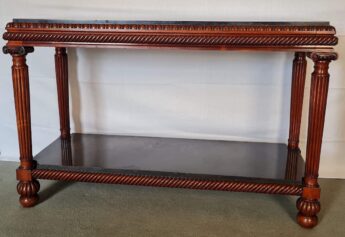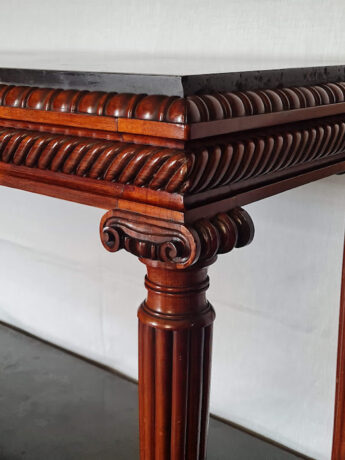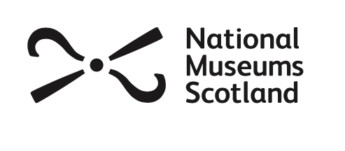A Lost Table returns to Paxton

Regular visitors to Paxton House will notice a new table standing in the Library. Actually, it is a ‘lost ‘ table, one which was commissioned for Paxton House in 1813 but which was re-acquired from a private collector. We are very excited that we have been able to re-acquire the table with the help of the National Fund for Acquisitions, the Art Fund and a private donor. The table is a part of Paxton House’s exceptional collection of the furniture of Scottish cabinet maker, William Trotter, which was commissioned by owners, George Home and his ward, Nancy Stephens, to furnish their newly completed extension to the house.

From Lobby to Library
The table’s design tells us that is was originally a lobby table. The most successful part of William Trotter’s business was designing furniture for the houses being built in the New Town of Edinburgh. A table of this type allowed visitors to leave their cards in the hall when they came to call if the house owner was out. In the busy social life of Edinburgh in the Regency period, a lobby table played an important role in regulating meetings between friends. Our table has always been multi-functional and the historic inventories in the archive tell us that it has been used in different rooms in the house through the centuries. Now in the Library, this piece of furniture allows the study and display of some of the large books that fill the shelves.
Commissioning the Table
The table is of rosewood ornately carved in a manner typical of William Trotter, who is considered Scotland’s premier cabinet maker. At Paxton, it is reunited with other Trotter furnishings in the Library and Picture Gallery. This collection of 40 items of furniture from settees to library steps is the most important collection of furniture by William Trotter and was his largest country house commission. We know that Trotter and his wife visited Nancy Stephens at Paxton House in 1813 to discuss the materials and design of this significant commission. This table, and two others in the Picture Gallery, were designed to show off the fine hard stone tops collected by George Home’s uncle Patrick in Italy in the 1770s, making this table completely unique. It was shipped from Edinburgh to the port at Berwick-upon-Tweed in 1814 and carried by horse and cart to Paxton House.
Why commission the table?
George Home was a lawyer and a writer to the Signet (responsible for documents that carried the royal seal) based in Edinburgh. As a busy lawyer and a single gentleman, his ward, Nancy, was in charge of running his country house at Paxton. Together, they planned the only addition to the 18th century house, built by George’s uncle Patrick. After Patrick’s death, George inherited his collections of books and works of art and needed more space to display them. The huge Picture Gallery at Paxton is still the largest in any country house in Scotland and today displays part of the collection of the National Galleries of Scotland. The Picture Gallery was seamlessly linked to the rooms of the main house by the new Library and Bust Room and the complete set of furnishings from William Trotter’s workshop create a unified design.
The lobby table is now beautifully restored, thanks to grants from the Pilgrim Trust and a private donor. We are proud to be able to share this exquisite piece of furniture with our visitors, an important piece of Scottish design and with so much to tell us about life in Scotland at the start of the nineteenth century.



Donate here.